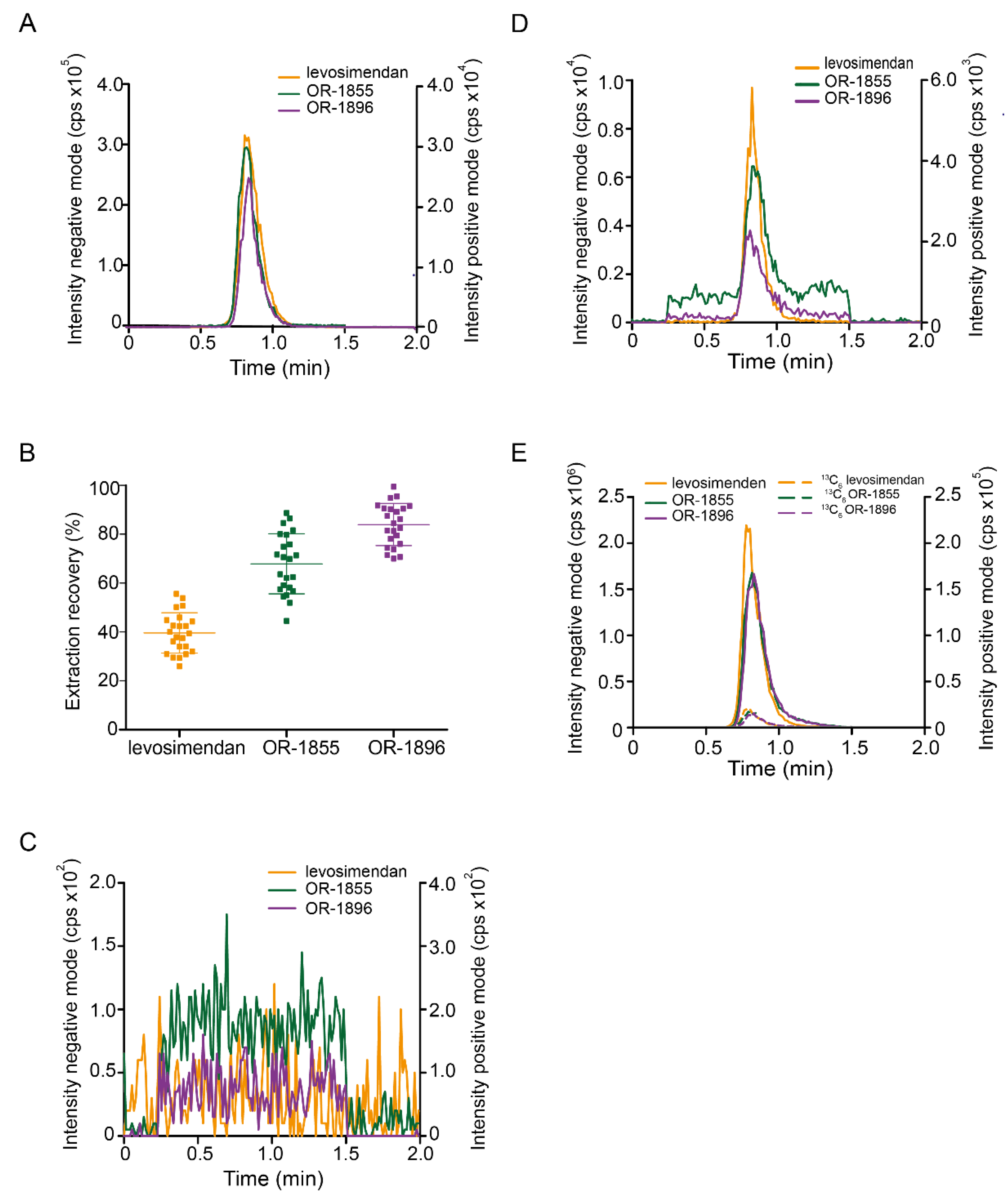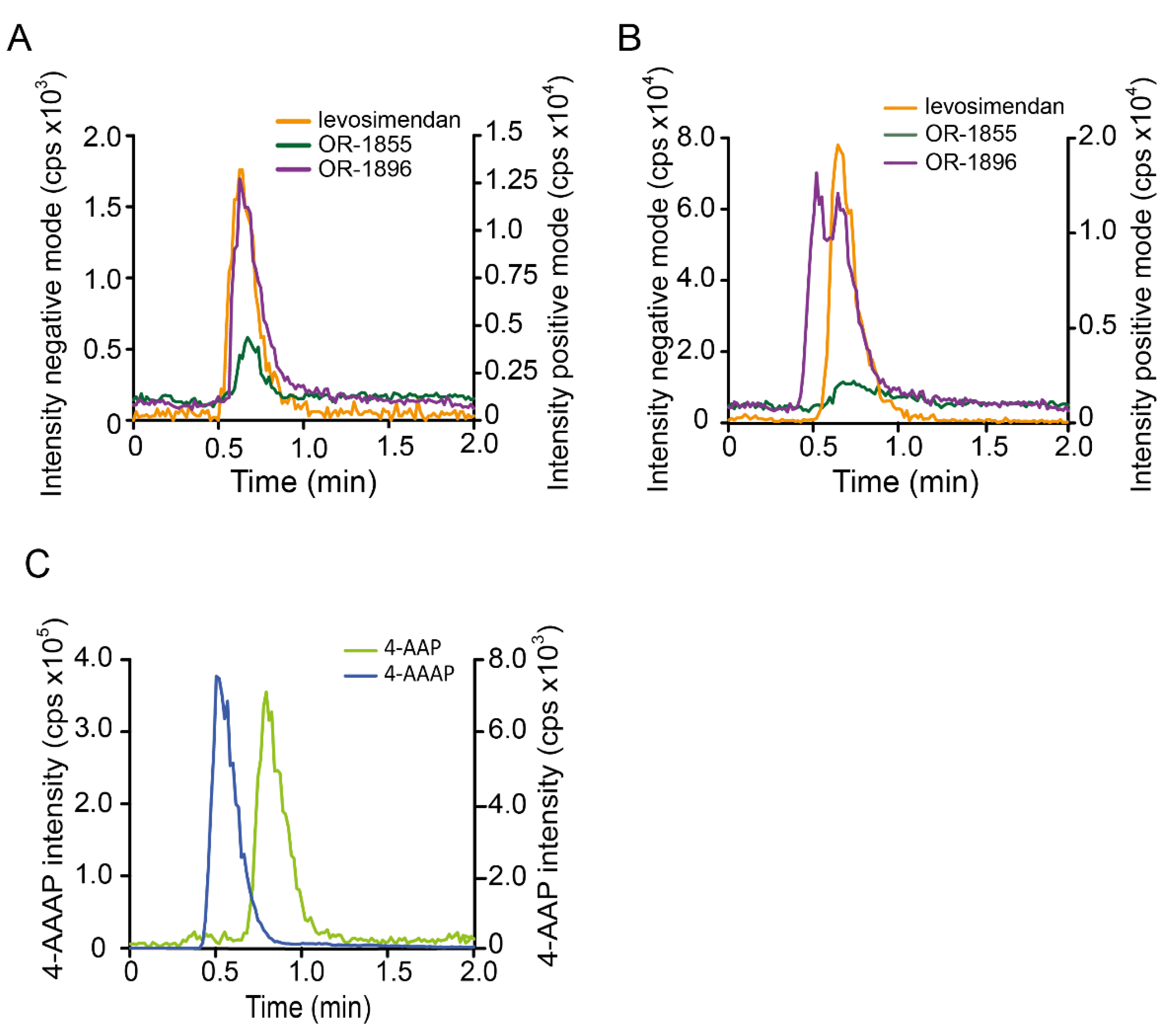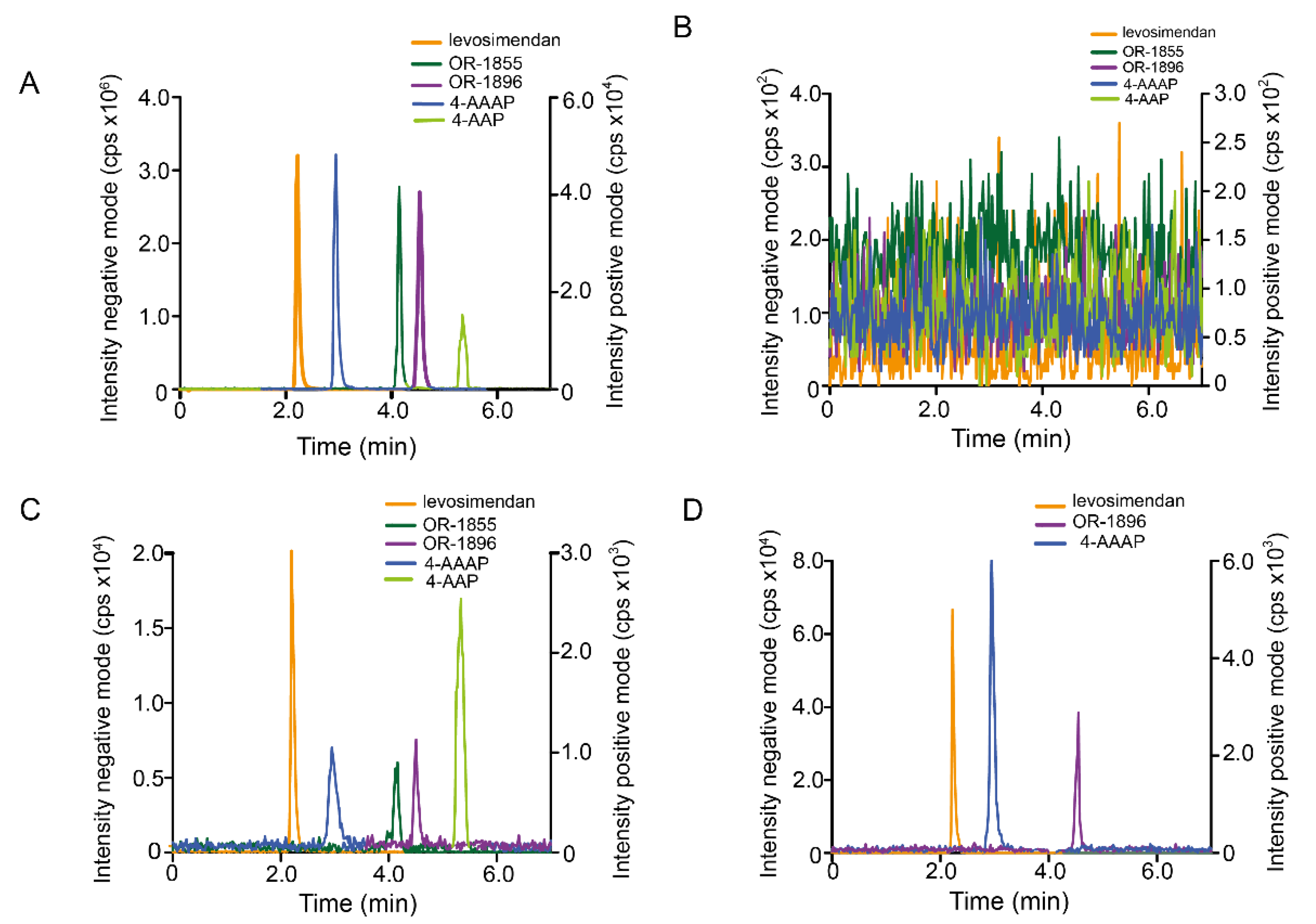Simultaneous LC-ESI-MS/MS Quantification of Levosimendan and Its Metabolites for Therapeutic Drug Monitoring of Cardiac Surgery Patients
Abstract
:1. Introduction
2. Materials and Methods
2.1. Materials
2.2. Sample Preparation—Liquid-Liquid Extraction
2.3. LC-ESI-MS/MS
2.4. Method Validation
2.4.1. Matrix Effect
2.4.2. Linearity
2.4.3. Selectivity
2.4.4. Carryover
2.4.5. Accuracy and Precision
2.4.6. Extraction Recovery
2.4.7. Bench Top Stability
2.5. Human Samples
2.6. Data Analysis
3. Results
3.1. LC-MS
3.2. Liquid-Liquid Extraction
3.3. Method Validation
3.3.1. Matrix Effect
3.3.2. Linearity
3.3.3. Selectivity
3.3.4. Accuracy and Precision
3.3.5. Bench Top Stability
3.3.6. LLE and LC-ESI-MS/MS with Serum and Plasma Samples
3.4. Quantification of Levosimendan and Its Metabolites in Patient Serum
3.5. Chromatographic Conditions for Levosimendan Samples Containing Metamizole Metabolites
3.6. Liquid-Liquid Extraction for Levosimendan Samples Containing Metamizole Metabolites
3.7. Method Validation for Levosimendan Samples Containing Metamizole Metabolites
3.7.1. Matrix Effect for 4-AAP and 4-AAAP
3.7.2. Linearity
3.7.3. Selectivity
3.7.4. Accuracy and Precision
3.8. Quantification of Levosimendan, OR-1855, OR-1896, 4-AAP, and 4-AAAP in Patient Serum
4. Discussion
5. Conclusions
Supplementary Materials
Author Contributions
Funding
Institutional Review Board Statement
Informed Consent Statement
Data Availability Statement
Conflicts of Interest
References
- Lancaster, M.K.; Cook, S.J. The effects of levosimendan on [Ca2+] (i) in guinea-pig isolated ventricular myocytes. Eur. J. Pharmacol. 1997, 339, 97–100. [Google Scholar] [CrossRef]
- Antila, S.; Kivikko, M.; Lehtonen, L.; Eha, J.; Heikkilä, A.; Pohjanjousi, P.; Pentikäinen, P.J. Pharmacokinetics of levosimendan and its circulating metabolites in patients with heart failure after an extended continuous infusion of levosimendan. Br. J. Clin. Pharmacol. 2004, 57, 412–415. [Google Scholar] [CrossRef]
- Puttonen, J.; Laine, T.; Ramela, M.; Häkkinen, S.; Zhang, W.; Pradhan, R.; Pentikäinen, P.; Koskinen, M. Pharmacokinetics and excretion balance of OR-1896, a pharmacologically active metabolite of levosimendan, in healthy men. Eur. J. Pharm. Sci. 2007, 32, 271–277. [Google Scholar] [CrossRef]
- Erdei, N.; Papp, Z.; Pollesello, P.; Édes, I.; Bagi, Z. The levosimendan metabolite OR-1896 elicits vasodilation by activating the K ATP and BK Ca channels in rat isolated arterioles. Br. J. Pharmacol. 2006, 148, 696–702. [Google Scholar] [CrossRef] [Green Version]
- Shi, W.Y.; Li, S.; Collins, N.; Cottee, D.B.; Bastian, B.C.; James, A.N.; Mejia, R. Peri-operative levosimendan in patients undergoing cardiac surgery: An overview of the evidence. Heart Lung Circ. 2015, 24, 667–672. [Google Scholar] [CrossRef] [Green Version]
- Turanlahti, M.; Boldt, T.; Palkama, T.; Antila, S.; Lehtonen, L.; Pesonen, E. Pharmacokinetics of levosimendan in pediatric patients evaluated for cardiac surgery. Pediatr. Crit. Care Med. 2004, 5, 457–462. [Google Scholar] [CrossRef]
- Põder, P.; Eha, J.; Sundberg, S.; Antila, S.; Heinpalu, M.; Loogna, I.; Planken, Ü.; Rantanen, S.; Lehtonen, L. Pharmacokinetic-pharmacodynamic interrelationships of intravenous and oral levosimendan in patients with severe congestive heart failure. Int. J. Clin. Pharmacol. Ther. 2003, 41, 365–373. [Google Scholar] [CrossRef]
- Antila, S.; Pesonen, U.; Lehtonen, L.; Tapanainen, P.; Nikkanen, H.; Vaahtera, K.; Scheinin, H. Pharmacokinetics of levosimendan and its active metabolite OR-1896 in rapid and slow acetylators. Eur. J. Pharm. Sci. 2004, 23, 213–222. [Google Scholar] [CrossRef]
- Puttonen, J.; Kantele, S.; Ruck, A.; Ramela, M.; Häkkinen, S.; Kivikko, M.; Pentikäinen, P.J. Pharmacokinetics of intravenous levosimendan and its metabolites in subjects with hepatic impairment. J. Clin. Pharmacol. 2008, 48, 445–454. [Google Scholar] [CrossRef]
- Kennedy, J.M.; Van Riji, A.M. Effects of surgery on the pharmacokinetic parameters of drugs. Clin. Pharmacokinet. 1998, 35, 293–312. [Google Scholar] [CrossRef]
- Figgitt, D.P.; Gillies, P.S.; Goa, K.L. Levosimendan. Drugs 2001, 61, 613–627. [Google Scholar] [CrossRef]
- Gordon, A.C.; Perkins, G.D.; Singer, M.; McAuley, D.F.; Orme, R.M.L.; Santhakumaran, S.; Mason, A.J.; Cross, M.; Al-Beidh, F.; Best-Lane, J.; et al. Levosimendan for the prevention of acute organ dysfunction in Sepsis. N. Engl. J. Med. 2016, 375, 1638–1648. [Google Scholar] [CrossRef] [Green Version]
- Shipkova, M.; Svinarov, D. LC–MS/MS as a tool for TDM Services: Where are we? Clin. Biochem. 2016, 49, 1009–1023. [Google Scholar] [CrossRef]
- Li, S.R.; Chen, X.Y.; Zhang, Y.F.; Li, G.X.; Jiang, C.M.; Zhong, D.F. Determination of levosimendan and its main metabolites in human plasma with HPLC-MS/MS method. Yaoxue Xuebao 2008, 43, 1053–1059. [Google Scholar]
- Puttonen, J.; Kantele, S.; Kivikko, M.; Häkkinen, S.; Harjola, V.P.; Koskinen, P.; Pentikäinen, P.J. Effect of severe renal failure and haemodialysis on the pharmacokinetics of levosimendan and its metabolites. Clin. Pharmacokinet. 2007, 46, 235–246. [Google Scholar] [CrossRef]
- Zhang, J.; Gage, E.M.; Ji, Q.C.; El-Shourbagy, T.A. A strategy for high-throughput analysis of levosimendan and its metabolites in human plasma samples using sequential negative and positive ionization liquid chromatography/tandem mass spectrometric detection. Rapid Commun. Mass Spectrom. 2007, 21, 2169–2176. [Google Scholar] [CrossRef]
- Vlase, L.; Kiss, B.; Bocsan, C.; Negrutiu, S.; Vlad, I.H.; Buzoianu, A. A high-throughput HPLC assay for levosimendan in human plasma with ESI-MS/MS detection. Farmacia 2015, 63, 821–827. [Google Scholar]
- U.S. Department of Health and Human Services. Food and Drug Administration. In Bioanalytical Method Validation Guidance for Industry; U.S. Department of Health and Human Services: Washington, DC, USA; Food and Drug Administration: Silver Spring, MD, USA, 2018; pp. 1–41. [Google Scholar]
- Matuszewski, B.K.; Constanzer, M.L.; Chavez-Eng, C.M. Strategies for the assessment of matrix effect in quantitative bioanalytical methods based on HPLC-MS/MS. Anal. Chem. 2003, 75, 3019–3030. [Google Scholar] [CrossRef]
- World Medical Association. World medical association declaration of helsinki, ethical principles for scientific requirements and research protocols. Bull. World Health Organ. 2013, 79, 373. [Google Scholar]
- Maurer, P.W. Mass Spectral Library of Drugs Poisons Pesticides Pollutants and Their Metabolites, 5th ed.; Wiley-VCH: Weinheim, Germany, 2016; ISBN 978-3-527-34327-0. [Google Scholar]
- Vogeser, M.; Seger, C. Pitfalls associated with the use of liquid chromatography-tandem mass spectrometry in the clinical laboratory. Clin. Chem. 2010, 56, 1234–1244. [Google Scholar] [CrossRef]
- Kivikko, M.; Antila, S.; Eha, J.; Lehtonen, L.; Pentikäinen, P.J. Pharmacokinetics of levosimendan and its metabolites during and after a 24-hour continuous infusion in patients with severe heart failure. Int. J. Clin. Pharmacol. Ther. 2002, 40, 465–471. [Google Scholar] [CrossRef] [PubMed]
- Jonsson, E.N.; Antila, S.; McFadyen, L.; Lehtonen, L.; Karlsson, M.O. Population pharmacokinetics of levosimendan in patients with congestive heart failure. Br. J. Clin. Pharmacol. 2003, 55, 544–551. [Google Scholar] [CrossRef] [PubMed]
- Andrade, S.; Bartels, D.B.; Lange, R.; Sandford, L.; Gurwitz, J. Safety of metamizole: A systematic review of the literature. J. Clin. Pharm. Ther. 2016, 41, 459–477. [Google Scholar] [CrossRef] [PubMed]
- Cascorbi, I. The Uncertainties of Metamizole Use. Clin. Pharmacol. Ther. 2021, 109, 1373–1375. [Google Scholar] [CrossRef] [PubMed]




| Serum | ||||||||||||||||
|---|---|---|---|---|---|---|---|---|---|---|---|---|---|---|---|---|
| LLOQ | Low | Middle | High | |||||||||||||
| Within Run | Mean | Acc. (%) | Prec. (%) | Mean | Acc. (%) | Prec. (%) | Mean | Acc. (%) | Prec. (%) | Mean | Acc. (%) | Prec. (%) | ||||
| 1. Series | Nom. Conc (nMl) | Calc. Conc (nMl) | Nom. Conc (nM) | Calc. Conc (nM) | Nom. Conc (nM) | Calc. Conc (nM) | Nom. Conc (nM) | Calc. Conc (nM) | ||||||||
| Levosimendan | 0.15 | 0.145 | 96.7 | 8.4 | 0.45 | 0.449 | 99.8 | 7.4 | 50 | 52.9 | 105.8 | 2.3 | 500 | 492 | 98.3 | 5.8 |
| OR-1855 | 0.50 | 0.471 | 94.2 | 9.2 | 1.50 | 1.39 | 92.7 | 2.6 | 50 | 45.2 | 90.4 | 7.0 | 500 | 467 | 93.5 | 4.6 |
| OR-1896 | 0.50 | 0.524 | 104.8 | 10.1 | 1.50 | 1.50 | 100.0 | 6.4 | 50 | 49.0 | 98.0 | 6.6 | 500 | 503 | 100.7 | 4.4 |
| 2. Series | ||||||||||||||||
| Levosimendan | 0.15 | 0.143 | 95.3 | 12.1 | 0.45 | 0.471 | 104.7 | 6.3 | 50 | 50.6 | 101.3 | 5.5 | 500 | 533 | 106.6 | 5.4 |
| OR-1855 | 0.50 | 0.518 | 103.6 | 11.3 | 1.50 | 1.50 | 100.0 | 5.2 | 50 | 50.4 | 100.8 | 8.6 | 500 | 481 | 96.1 | 8.3 |
| OR-1896 | 0.50 | 0.461 | 92.2 | 9.1 | 1.50 | 1.61 | 107.3 | 4.4 | 50 | 52.7 | 105.4 | 12.2 | 500 | 521 | 104.3 | 7.4 |
| 3. Series | ||||||||||||||||
| Levosimendan | 0.15 | 0.136 | 90.7 | 6.3 | 0.45 | 0.407 | 90.4 | 5.1 | 50 | 53.9 | 107.8 | 2.1 | 500 | 505 | 101.1 | 1.8 |
| OR-1855 | 0.50 | 0.443 | 88.6 | 5.3 | 1.50 | 1.51 | 100.7 | 7.3 | 50 | 53.8 | 107.6 | 3.0 | 500 | 522 | 104.4 | 5.1 |
| OR-1896 | 0.50 | 0.522 | 104.4 | 6.9 | 1.50 | 1.38 | 92.0 | 2.9 | 50 | 50.8 | 101.6 | 4.5 | 500 | 477 | 95.4 | 5.3 |
| Between run | ||||||||||||||||
| Levosimendan | 0.15 | 0.141 | 94.0 | 9.1 | 0.45 | 0.442 | 98.2 | 8.6 | 50 | 52.5 | 105.0 | 4.2 | 500 | 510 | 102.0 | 5.6 |
| OR-1855 | 0.50 | 0.477 | 95.4 | 10.9 | 1.50 | 1.47 | 98.0 | 6.4 | 50 | 49.9 | 99.6 | 9.5 | 500 | 490 | 98.0 | 7.6 |
| OR-1896 | 0.50 | 0.502 | 100.4 | 10.1 | 1.50 | 1.50 | 100.0 | 8.0 | 50 | 50.8 | 101.6 | 8.5 | 500 | 501 | 100.1 | 6.6 |
| 4. Series Including LLE | ||||||||||||||||
| Levosimendan | 0.45 | 0.462 | 102.7 | 2.8 | 1.35 | 1.23 | 91.1 | 2.3 | 50 | 46.6 | 93.2 | 1.8 | 500 | 476 | 95.2 | 1.8 |
| OR-1855 | 1.00 | 0.956 | 95.6 | 8.3 | 4.50 | 4.39 | 97.6 | 3.0 | 50 | 50.7 | 101.4 | 4.7 | 500 | 468 | 93.6 | 3.3 |
| OR-1896 | 1.00 | 0.889 | 88.9 | 3.3 | 4.50 | 4.25 | 94.4 | 2.0 | 50 | 47.1 | 94.2 | 1.6 | 500 | 457 | 91.4 | 1.3 |
| 5. Series Including LLE | Plasma | |||||||||||||||
| Levosimendan | 0.45 | 0.403 | 89.6 | 3.2 | 1.35 | 1.55 | 114.8 | 0.4 | 50 | 56.3 | 112.6 | 0.9 | 500 | 500 | 100.0 | 3.2 |
| OR-1855 | 1.00 | 0.990 | 99.0 | 11.2 | 4.50 | 5.10 | 113.3 | 2.4 | 50 | 56.3 | 112.6 | 2.0 | 500 | 550 | 110.1 | 4.5 |
| OR-1896 | 1.00 | 0.930 | 93.0 | 7.5 | 4.50 | 4.61 | 102.4 | 1.4 | 50 | 56.1 | 112.2 | 3.5 | 500 | 453 | 90.5 | 4.1 |
| Serum | ||||||||||||||||
|---|---|---|---|---|---|---|---|---|---|---|---|---|---|---|---|---|
| LLOQ | Low | Middle | High | |||||||||||||
| Within Run | Mean (nM) | Acc. (%) | Prec. (%) | Mean (nM) | Acc. (%) | Prec. (%) | Mean (nM) | Acc. (%) | Prec. (%) | Mean (nM) | Acc. (%) | Prec. (%) | ||||
| 1. Series | Nom. Conc (nMl) | Calc. Conc (nMl) | Nom. Conc (nMl) | Calc. Conc (nMl) | Nom. Conc (nMl) | Calc. Conc (nMl) | Nom. Conc (nMl) | Calc. Conc (nMl) | ||||||||
| Levosimendan | 0.45 | 0.428 | 95.1 | 9.6 | 1.35 | 1.39 | 103.0 | 2.5 | 75 | 84.4 | 112.5 | 1.8 | 300 | 284 | 94.7 | 1.8 |
| OR-1855 | 1.50 | 1.52 | 101.3 | 6.5 | 4.50 | 4.84 | 107.5 | 6.3 | 75 | 78.8 | 105.1 | 6.6 | 300 | 316 | 105.2 | 5.5 |
| OR-1896 | 1.50 | 1.50 | 100.0 | 8.0 | 4.50 | 4.57 | 101.6 | 2.9 | 75 | 84.2 | 112.3 | 1.4 | 300 | 318 | 106.1 | 5.1 |
| 4-AAP | 50 | 52.3 | 104.6 | 5.6 | 150 | 162.0 | 108.0 | 6.3 | 350 | 384 | 109.8 | 4.1 | 750 | 829 | 110.5 | 2.5 |
| 4-AAAP | 1.35 | 1.33 | 98.5 | 9.0 | 4.05 | 3.86 | 95.3 | 3.1 | 75 | 78.1 | 104.1 | 7.4 | 500 | 570 | 114.0 | 0.7 |
| 2. Series | ||||||||||||||||
| Levosimendan | 0.45 | 0.438 | 97.3 | 1.7 | 1.35 | 1.41 | 104.4 | 5.0 | 75 | 82.3 | 109.7 | 3.4 | 300 | 301 | 100.3 | 2.4 |
| OR-1855 | 1.50 | 1.50 | 100.0 | 6.6 | 4.50 | 4.60 | 102.2 | 8.8 | 75 | 69.9 | 93.2 | 6.3 | 300 | 296 | 98.7 | 3.4 |
| OR-1896 | 1.50 | 1.52 | 101.3 | 7.4 | 4.50 | 4.36 | 96.9 | 3.6 | 75 | 70.9 | 94.5 | 7.8 | 300 | 285 | 95.1 | 2.6 |
| 4-AAP | 50 | 57.4 | 114.8 | 3.0 | 150 | 161.0 | 107.3 | 5.1 | 350 | 391 | 111.6 | 5.4 | 750 | 745 | 99.3 | 9.4 |
| 4-AAAP | 1.35 | 1.49 | 110.4 | 5.2 | 4.05 | 4.53 | 111.9 | 1.5 | 75 | 86.2 | 114.9 | 0.3 | 500 | 509 | 101.7 | 8.6 |
| 3. Series | ||||||||||||||||
| Levosimendan | 0.45 | 0.432 | 96.0 | 6.5 | 1.35 | 1.35 | 100.0 | 3.2 | 75 | 80.9 | 107.9 | 2.4 | 300 | 275 | 91.7 | 4.4 |
| OR-1855 | 1.50 | 1.51 | 100.7 | 5.8 | 4.50 | 4.45 | 98.9 | 4.8 | 75 | 74.5 | 99.3 | 3.9 | 300 | 291 | 96.9 | 3.9 |
| OR-1896 | 1.50 | 1.39 | 92.7 | 10.1 | 4.50 | 4.44 | 98.7 | 8.2 | 75 | 71.9 | 95.9 | 2.6 | 300 | 283 | 94.3 | 4.3 |
| 4-AAP | 50 | 55.7 | 111.4 | 5.7 | 150 | 166.0 | 110.7 | 3.5 | 350 | 394 | 112.6 | 1.5 | 750 | 809 | 107.8 | 5.5 |
| 4-AAAP | 1.35 | 1.48 | 109.6 | 4.0 | 4.05 | 4.37 | 107.9 | 7.0 | 75 | 85.0 | 113.3 | 1.0 | 500 | 570 | 113.9 | 0.9 |
| Between run | ||||||||||||||||
| Levosimendan | 0.45 | 0.433 | 96.8 | 6.3 | 1.35 | 1.39 | 103.0 | 3.9 | 75 | 82.5 | 110.0 | 3.0 | 300 | 287 | 95.6 | 5.0 |
| OR-1855 | 1.50 | 1.51 | 100.7 | 5.8 | 4.50 | 4.63 | 102.9 | 7.3 | 75 | 74.4 | 99.2 | 7.4 | 300 | 301 | 100.3 | 5.5 |
| OR-1896 | 1.50 | 1.47 | 98.0 | 8.9 | 4.50 | 4.46 | 99.1 | 5.4 | 75 | 75.7 | 100.9 | 9.2 | 300 | 296 | 98.5 | 6.9 |
| 4-AAP | 50 | 55.1 | 110.2 | 6.0 | 150 | 163.0 | 108.7 | 4.9 | 350 | 390 | 111.3 | 3.9 | 750 | 794 | 105.9 | 7.4 |
| 4-AAAP | 1.35 | 1.43 | 105.9 | 7.8 | 4.05 | 4.25 | 104.9 | 8.2 | 75 | 83.1 | 110.8 | 5.8 | 500 | 549 | 109.9 | 6.9 |
Publisher’s Note: MDPI stays neutral with regard to jurisdictional claims in published maps and institutional affiliations. |
© 2022 by the authors. Licensee MDPI, Basel, Switzerland. This article is an open access article distributed under the terms and conditions of the Creative Commons Attribution (CC BY) license (https://creativecommons.org/licenses/by/4.0/).
Share and Cite
Kipka, H.; Tomasi, R.; Hübner, M.; Liebchen, U.; Hagl, C.; Wanner, K.T.; Mannell, H.; Höfner, G. Simultaneous LC-ESI-MS/MS Quantification of Levosimendan and Its Metabolites for Therapeutic Drug Monitoring of Cardiac Surgery Patients. Pharmaceutics 2022, 14, 1454. https://doi.org/10.3390/pharmaceutics14071454
Kipka H, Tomasi R, Hübner M, Liebchen U, Hagl C, Wanner KT, Mannell H, Höfner G. Simultaneous LC-ESI-MS/MS Quantification of Levosimendan and Its Metabolites for Therapeutic Drug Monitoring of Cardiac Surgery Patients. Pharmaceutics. 2022; 14(7):1454. https://doi.org/10.3390/pharmaceutics14071454
Chicago/Turabian StyleKipka, Hannah, Roland Tomasi, Max Hübner, Uwe Liebchen, Christian Hagl, Klaus T. Wanner, Hanna Mannell, and Georg Höfner. 2022. "Simultaneous LC-ESI-MS/MS Quantification of Levosimendan and Its Metabolites for Therapeutic Drug Monitoring of Cardiac Surgery Patients" Pharmaceutics 14, no. 7: 1454. https://doi.org/10.3390/pharmaceutics14071454
APA StyleKipka, H., Tomasi, R., Hübner, M., Liebchen, U., Hagl, C., Wanner, K. T., Mannell, H., & Höfner, G. (2022). Simultaneous LC-ESI-MS/MS Quantification of Levosimendan and Its Metabolites for Therapeutic Drug Monitoring of Cardiac Surgery Patients. Pharmaceutics, 14(7), 1454. https://doi.org/10.3390/pharmaceutics14071454






